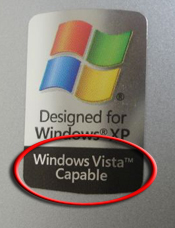Vista Capable vs. XP Ready: Microsoft's semantic choices make a big difference


The incompatibility forced ZDNet reader Tim Patterson to go off-script in his attempt to upgrade from Windows XP to Windows Vista; an episode that raises the question of whether more should have been done by Microsoft, Acer, or both to keep Patterson and others like him from forging off into the technical land of DOS command prompts in order to remedy the problem. Patterson is a technical user who is pretty comfortable with issuing text-based commands and their cryptic parameters to an operating system like Windows or Linux. But Acer caters to many consumers who are not -- consumers who, when selecting a system on the basis of its ability to be upgraded to Windows Vista (the reason for the sticker in the first place), probably shouldn't be subjected to the incompatibility.
So who is to blame? Microsoft? Or Acer?
On the one hand, if Acer wants to avoid unnecessary telephone support calls while offering the best possible user experience to its customers, the right thing to do regardless of whether Microsoft disallows FAT32 or not (in order to qualify for the sticker) is to make sure that systems with the Windows Vista Capable sticker on them are far more prepared to be upgraded to Vista than they are (this requires the NTFS filesystem which is compatible with Windows XP).
On the other, Acer has plausible deniability. Eschewing the FAT32 filesystem in favor of NTFS is not required by Microsoft for a system to qualify for the Windows Vista Capable sticker. Technically, Acer met Microsoft's requirements in order to affix the sticker onto its systems. Perhaps the burden then is Microsoft's for not requiring systems to be preconfigured with the NTFS filesystem in order to qualify for the sticker.
Upon closer inspection, Microsoft seems to be adjusting the semantics of what the market normally perceives to mean "compatibility." As you can see, Microsoft used "Ready", "Designed For", and now it's using "Capable." To get an expert's point of view, I checked with Richmond Thomason, Professor of Linguistics, Philosophy, and Computer Science at the University of Michigan in Ann Arbor. Semantics is one of Thomason's areas of expertise. Thomason agreed that there are semantic differences between Ready, Designed For, and Capable but footnoted his feedback with the fact that he's not an expert in writing copy for advertising. What I was most interested in though is what customers' perceptions might be. Regarding "Ready" and "Designed For," Thomason said:
Ready means that you don't have to do anything
acceptexcept fire it up. Or some extremely minimal procedures are enough to get it to work. Designed For means just what it says. It suggests pretty strongly it should not be very hard to for the customer to get it t work.
But according to Thomason, any of the "a-ble words" (pronounced ahh-bell) like "capable" or "compatible" can be problematic:
A-ble words have a lot of waffle room in them. Any box you buy on the market is Linux compatible. But not everyone can install it. Compatible might mean you have to do all kinds of stuff. You might have to read a manual and learn how to do some complicated installation. You might have to build a kernel. If I say I'm capable of speaking Finnish, it can mean I've learned the language. But it can also mean that I can learn it because of how I've been able to learn other languages. To say a car is startable suggests that it will start if you put the key in it. But it could also you have to get a jump start. In other words, there's room for more complicated stuff. If the engine is lying there in smoking pieces, I supose it isn't startable. So, there's a limit to the waffle room. But there's also a possibility that what would have to be tried to get the car to start is beyond the capacities of certain people. For example, not everyone can jump start a car.
Indeed, looking at the Windows Vista Capable Web page on Microsoft's Web site, capable is all about the capability of the hardware. In other words, just because a system is capable of running Windows Vista doesn't mean that its ready to run Windows Vista.
Prior to the launching the Windows Vista Capable program, semantic choices were undoubtedly debated. I've been in enough meetings to know that even with press releases and advertising copy (heck, "Windows Vista Capable" is only three words), copywriters and management often agonize over every word. "Capable" was not randomly selected. With "XP Ready" already under its belt, there was clearly a deliberate decision to go with "capable" instead of "ready."
Going back to the blame game, the question then becomes, if you're going to blame Microsoft, what is it that you're going to blame it for? Do you suspect that "capable" may have been deliberately selected to allow for the ambiguity it offers? Or was Microsoft simply remiss in excluding certain Vista-readiness items from the Windows Vista Capable program requirements? Are are they the same thing?
Here's the poll.
[poll id=9]